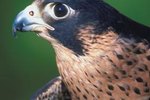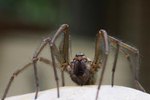
Bats are frequently viewed as scary and menacing, often seen adorning homes during Halloween or making appearances in horror movies. Despite their reputation, these flying mammals are small and shy. The bats of Oklahoma are small insect-eating bats called microbats. Some 22 different species of bats call Oklahoma home.
Insect-Eating Bats
All species of bats living in Oklahoma are insect eaters. These small bats are called microbats, as opposed to larger fruit-eating megabats. Insect-eating bats spend the day roosting in a dark spot, coming out at dusk to hunt insects. They love to munch on moths, mosquitoes and June bugs, and they're capable of consuming up to 3,000 mosquitoes in one night. These bats have small eyes and large ears, depending on echolocation to find their prey and get around. The little and big brown bats and Mexican free-tailed bats are the most common species in Oklahoma. Other species include the pallid, evening, hoary and silver-haired bats.
Mexican Free-Tailed Bat
The Mexican free-tailed bat, also called the Brazilian free-tailed bat, is a common and widespread species of bat in Oklahoma. They’re only 3 or 4 inches long, with short brown fur. They have small eyes, larger, rounded ears and a distinctive, wrinkled upper lip. They get their name because of the small, thin tail extending from the back end of their bodies. In the winter, these bats migrate from Oklahoma to Mexico.
Little Brown Bat
These little bats have glossy fur in colors ranging from golden brown to dark brown. Their compact faces make them resemble mice with wings. They are only 3 to 4 inches long, with a wing-span of roughly 10 inches. These bats hibernate during the winter, from November to March or May. Little brown bats can eat half their body weight in insects and love to hunt swarms of bugs for easy pickings.
Big Brown Bat
While they have big in their name, big brown bats are usually only 5 inches long. They have a wingspan of a little better than a foot wide. Big brown bats have tan to milk chocolate bodies on top, and pink to buff colored bellies. Big brown bats' favorite food is beetles, but they will also eat flies, ants, wasps and dragonflies. Like little brown bats, they aren’t migratory and will hibernate during the winter.
References
- Oklahoma Department of Wildlife Conservation: Oklahoma Bats
- Foundation for National Parks & Wildlife: Backyard Buddies
- University of Michigan: Brazilian Free-Tailed Bat
- University of Michigan: Little Brown Bat
- University of Michigan: Big Brown Bat
- The Skunk Whisperer: Common Types of Bats in Oklahoma
Photo Credits
-
David De Lossy/Photodisc/Getty Images




